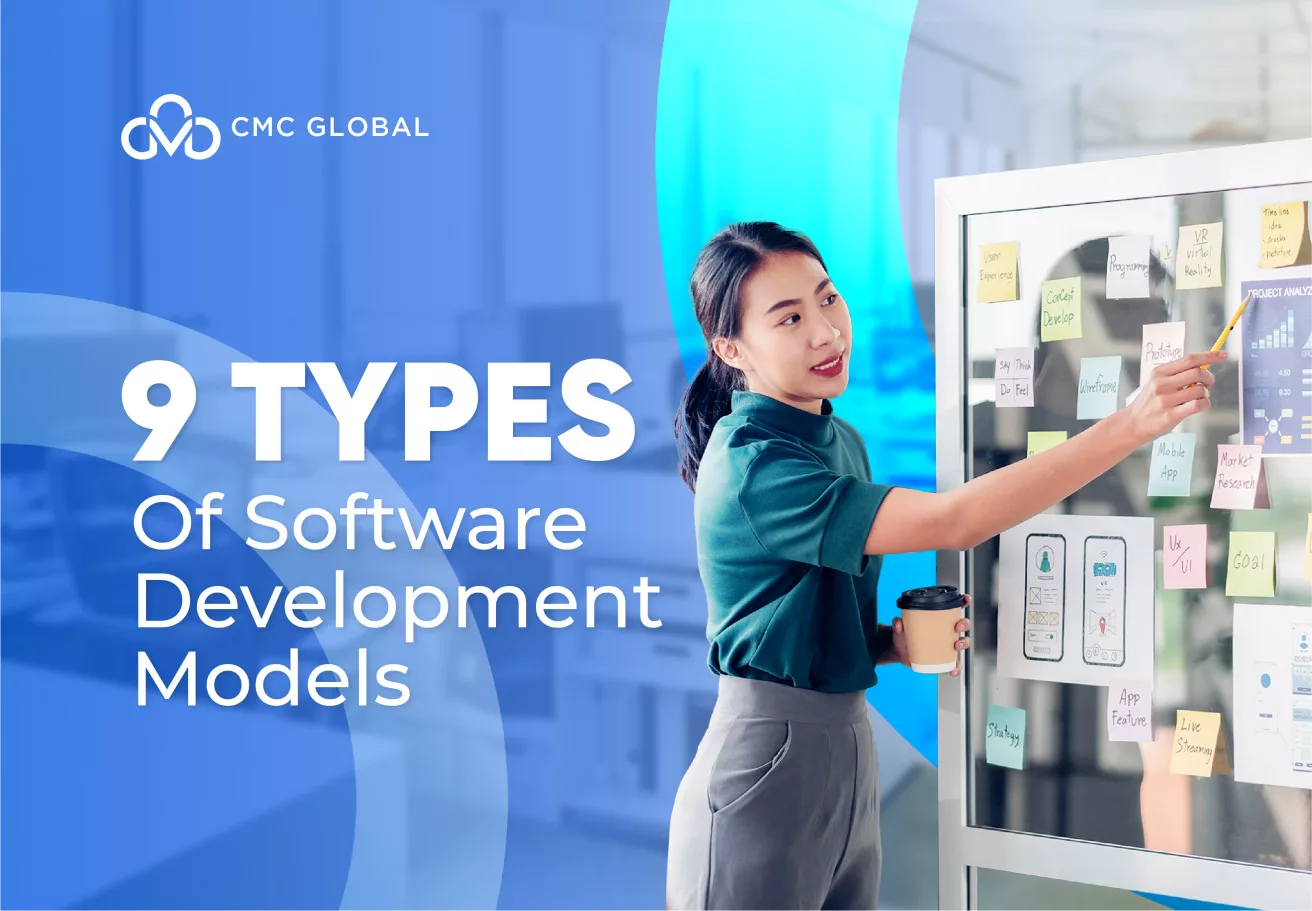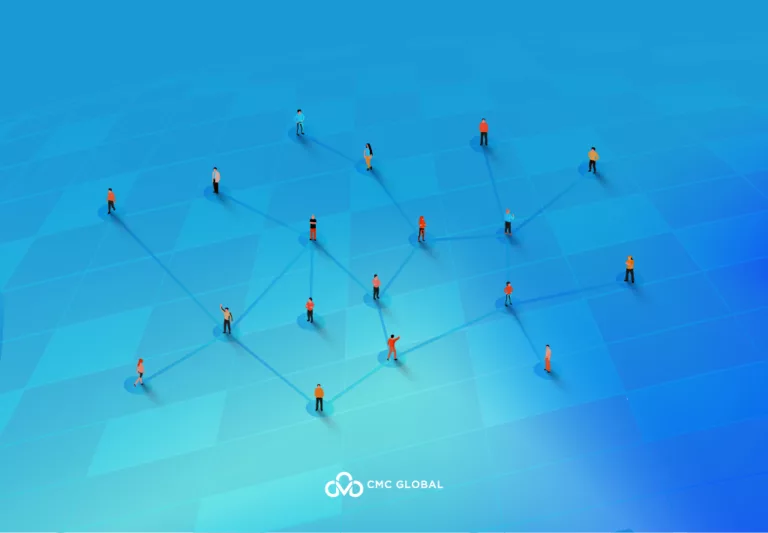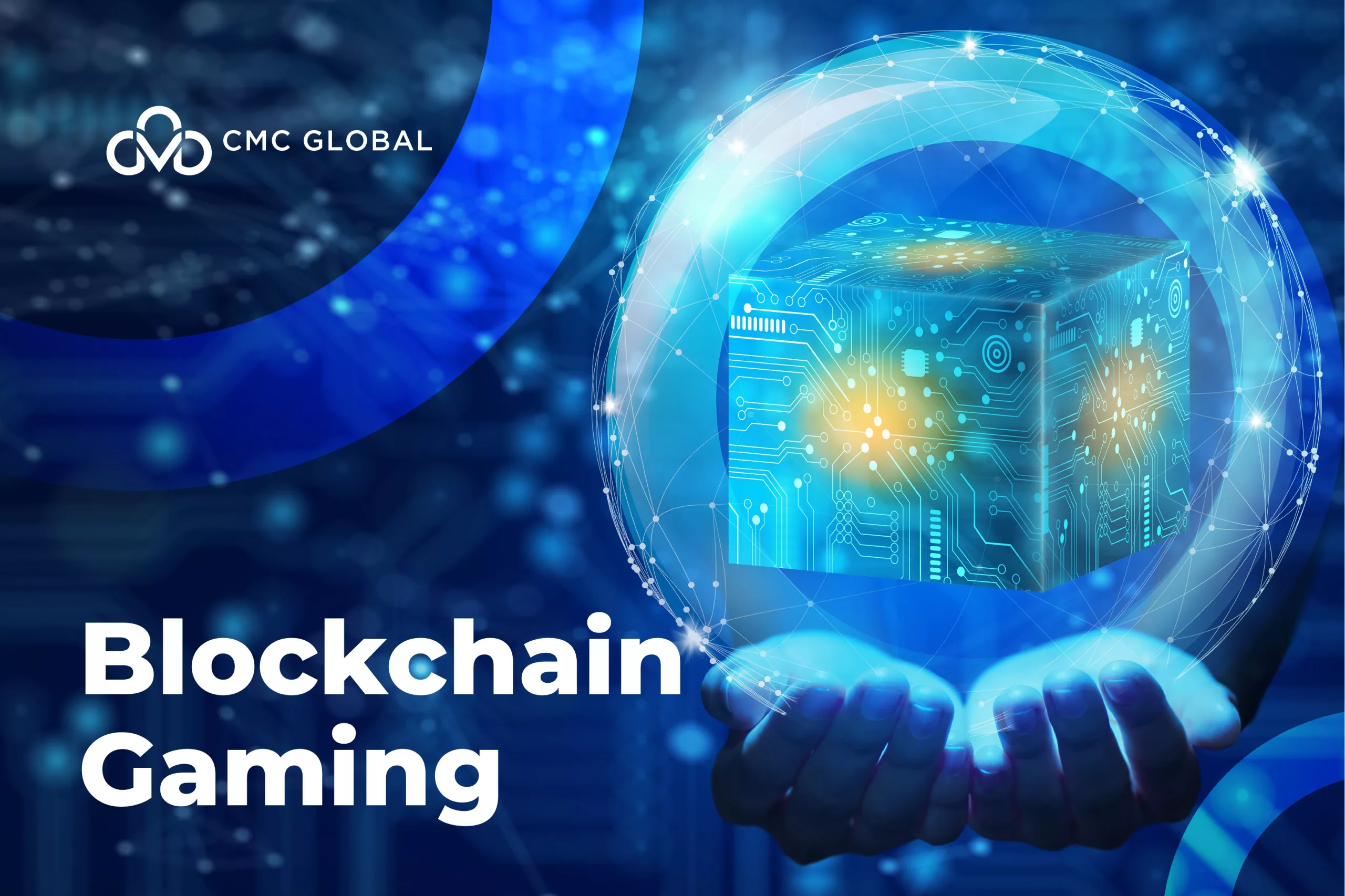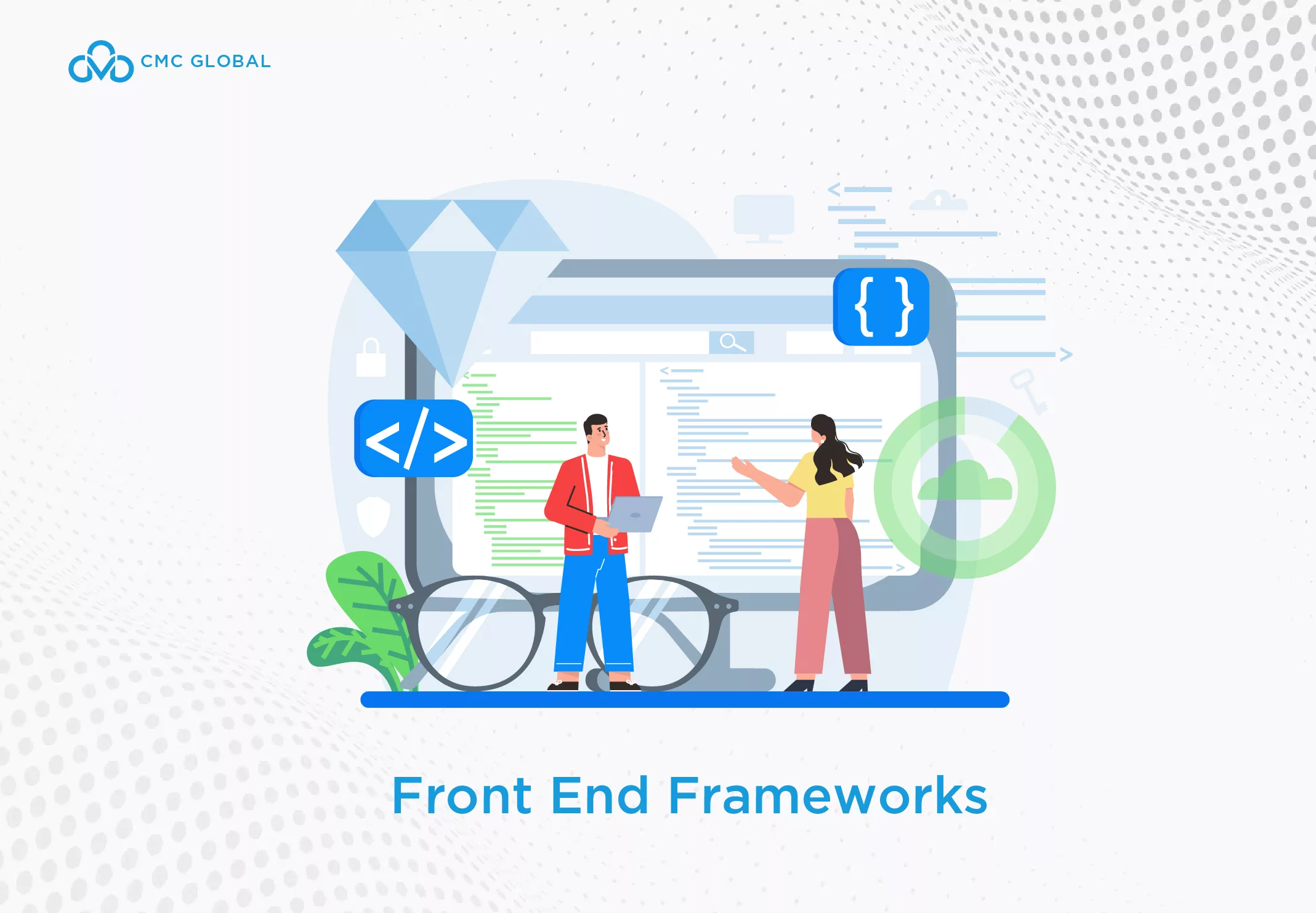When building a fresh app or software development project, it is crucial to take into account the multiple stages required for its deployment. These essential stages include development, coding/implementation, testing, and ongoing maintenance to ensure the software operates effectively. Regardless of the nature of the software or app being crafted, having a well-thought-out development and testing plan is indispensable for achieving project success.
Below, we will go through the most commonly used development and software lifecycle management models, along with their phases and when to use.
6 Types of Software Development Life Cycle (SDLC) Models
The Software Development Life Cycle (SDLC) is a conceptual framework used in project management to outline the various phases involved in an information system development project, starting from the initial feasibility assessment through to the ongoing maintenance of the final application.
Various models for software development life cycles exist, offering distinct approaches to the design and specification stages during software development. These models are alternatively referred to as “Software Development Process Models.” Each process model adheres to a specific set of phases tailored to its type, all aimed at ensuring the achievement of success at each step of the software development process.
#1 Waterfall Model
The waterfall model is a widely used SDLC model. The entire software development process is separated into different phases.
The waterfall model is a continuous software development approach in which development can be seen as a constant downhill flow (like a waterfall) through the processes of requirements analysis, design, implementation, verification, deployment, and maintenance.
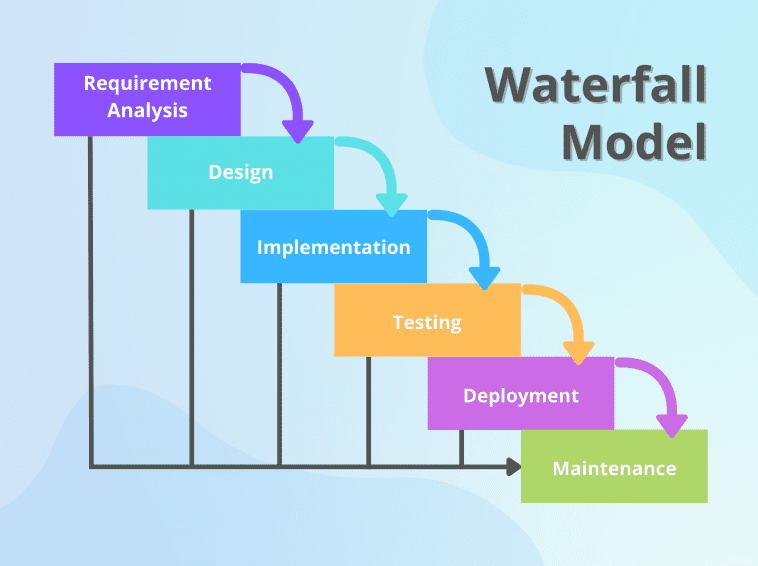
Waterfall model
Phases of the Waterfall Model
- Analysis phase: Planning, analyzing, and clarifying requirements
- Design phase: System design and specification
- Implementation phase: Coding and unit tests
- Verification phase: System integration, system and integration tests
- Deployment phase: System Deployment
- Maintenance phase: Delivery, maintenance, and enhancement
When to use
- When you know exactly what you want the result to look like.
- When clients are unable to change the scope of a project after it has started.
- Concept and definition are critical for success (but not speed).
#2 V-Model
The V-Model, an extension of the Waterfall Model, also operates as a sequential flow. Instead of advancing in a straight line downhill, the software development lifecycle curves upwards after coding (for each of the testing phases).
On one side, there are verification phases, and on the other, there are validation phases. This strategy is appropriate for projects where the software needs and tools are known in advance.
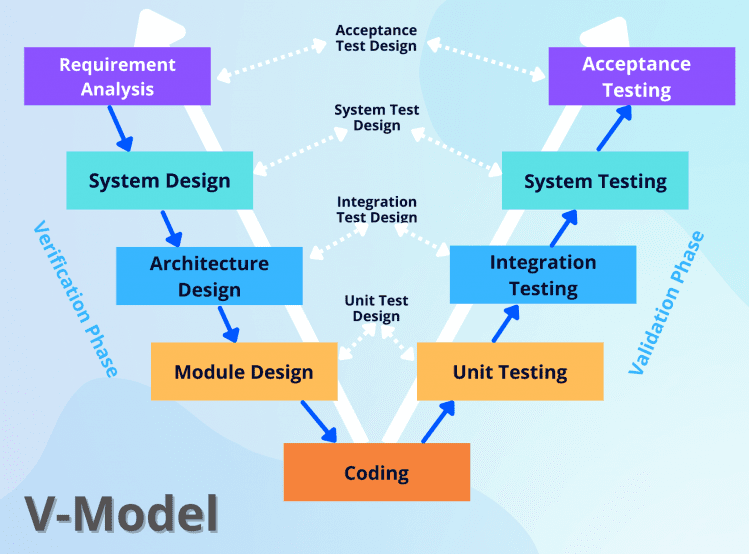
V model
Phases of the V-model
Verification Phase
- Requirement Analysis: In the verification phase, the initial step involves comprehending customer expectations for our products through extensive communication with them.
- System Design: Once the customers’ requirements and product expectations are identified, a comprehensive system design is created to guide product development.
- Architectural Design: The system design is broken down into various modules based on their functions, and the data exchange between these internal modules and other systems is defined.
- Module Design: Further division of the designs into smaller, more detailed modules is carried out.
Validation Phases
- Unit Testing: During the validation phase, unit testing is performed to identify and rectify code-level or unit-level bugs.
- Integration Testing: Integration testing is conducted to verify the internal communication between the different modules within the system.
- System Testing: The validation phase also includes system testing, which assesses both the functional and non-functional requirements of the developed application.
- User Acceptance Testing (UAT): UAT, a critical component of validation, assesses the usability of the developed system in a real-world context.
When to use
- When the criteria and goals are clear and straightforward.
- When technical requirements, such as technical resources and technical specialists, are readily available.
- Failures are acceptable when a system is developed.
#3 Incremental & Iterative Model
Iterative and incremental software development is an approach to software development characterized by a repetitive cycle of releasing updates and steadily incorporating new features.
This methodology commences with the planning stage and progresses through multiple iterative development cycles, where continuous user feedback informs the addition of incremental features. Ultimately, each cycle culminates in the implementation of the software.
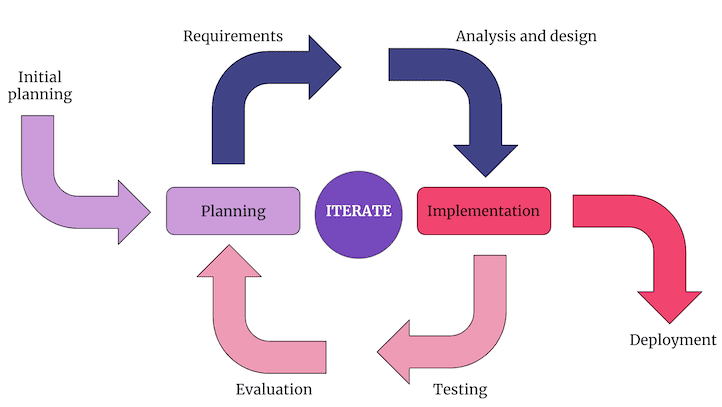
Iterative and incremental model
Phases of the Incremental Model
- Initiation Phase: At the project’s outset, the initiation phase focuses on addressing high-level scope, requirements, and potential risks.
- Elaboration Phase: During the elaboration phase, a functional architecture is established to mitigate risks identified in the initial phase and meet non-functional criteria.
- Build Phase: In this phase, the architecture components are progressively built using production-ready code. This involves activities such as functional requirement analysis, implementation, design, and thorough testing.
- Transition Phase: The transition phase marks the delivery of the system to the production operating environment.
When to use
The Incremental and Iterative Model finds applicability in the following scenarios:
- Urgent need for swiftly delivering essential functionality.
- The emergence of a novel technological advancement that can enhance project execution.
- When the project team lacks familiarity with the specific domain or subject area.
- When an organization harbors ambitious goals for substantial enhancements and improvements.
#4 Spiral Model
The Spiral Model represents a particular approach to Software Development in which activities are organized in a spiral pattern and executed in the sequence determined by their prioritization through risk analysis.
Within each iteration of this model, the goals and options are selected according to specific attributes. These attributes encompass personal experience, criteria for fulfillment, and forms of project management.
The model can be visualized in two forms: the angular form, which exclusively signifies the software development aspect within the project, and the radial form, which illustrates the increasing cost associated with longer durations required for each iteration’s completion.
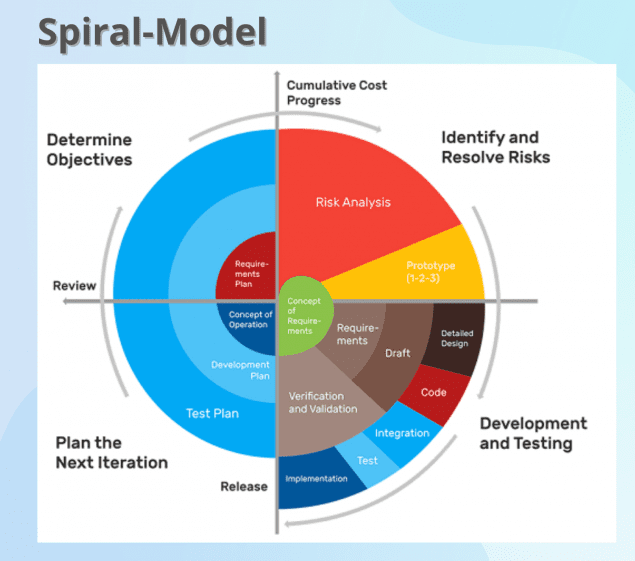
Spiral model
Phases of the Spiral Model
The phases within the spiral model encompass the following:
- Planning Phase: Initially, objectives and goals are identified and established. Subsequently, various alternative approaches that offer the best potential for achieving these objectives are presented. This stage heavily relies on ongoing communication between the customer and the project management team.
- Risk Analysis Phase: During this phase, potential hazards are identified while planning and finalizing the risk reduction strategy. Each identified risk undergoes a thorough examination, and if necessary, prototypes may be developed to eliminate any ambiguity in requirements. Precautions are taken to minimize these risks.
- Engineering Phase: This stage involves the actual coding, testing, and deployment of the software. The choice of the development model is determined by the level of risk identified for that specific phase, as per the risk assessment conducted.
- Evaluation Phase: Here, the client evaluates the software program. It is decided whether to proceed with the next cycle or not, and planning for the subsequent phase of the project takes place.
When to use
The strengths of the spiral model become particularly evident in scenarios where:
- Frequent software releases are advantageous and necessary.
- Prototyping plays a significant role in the development process.
- Rigorous risk and cost management are of paramount importance.
- The project entails either a medium to high level of risk or an exceptionally high level of risk.
- Requirement criteria are challenging to grasp clearly.
- A dynamic environment with ongoing and unpredictable changes is prevalent.
- The project’s long-term commitment is jeopardized for economic or other reasons.
#5 RUP Model
The Rational Unified Process (RUP) is a software development approach equipped with a variety of tools designed to support the creation of the end product and its associated tasks. RUP is an object-oriented methodology used for both project management and the development of high-quality software.
RUP is a collection of adaptable methods tailored to the specific needs and circumstances of each organization, rather than a rigid system with fixed procedures.

The Rational Unified Process
Phases of the RUP Model
- Initiation: The fundamental concept is visualized and initiated.
- Development: The design of use cases and architecture takes place.
- Building: Activities span from design to the final product.
- Handover: Subsequent activities are undertaken to guarantee customer contentment.
When to use
- In situations where requirements are subject to continual alterations.
- When there is access to precise and reliable information and data.
- When there is a need for specific integrations at various stages of the development process.
Read more: Top 12 Common Types of Software Development
#6 Prototype Model
In the process of developing software or applications, it is common practice to employ a prototype model. This model serves as an early, functional rendition that can be utilized as a demonstration or representation of the project.
Prototyping serves as an excellent means to gather feedback on requirements, functionality, and usability, thereby facilitating a smoother and more efficient progression in the product’s final development.
A prototype model essentially functions as a working version of the product, providing a glimpse into the core features of the eventual product or system.
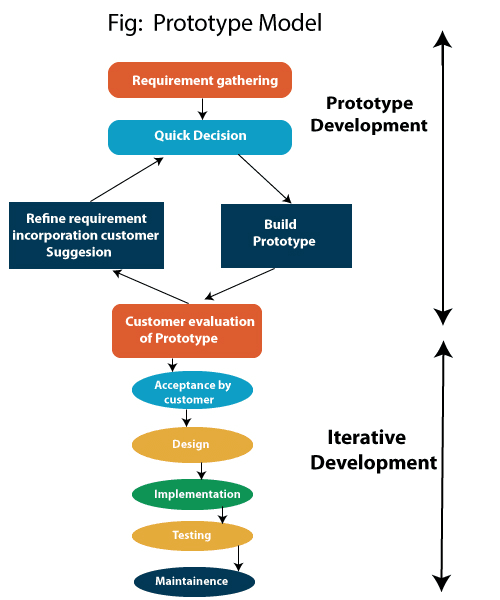
Prototype model
Phases of Prototype Model
- Requirement Identification: The model’s outset involves the identification of the necessary requirements for the envisioned system.
- Design: Following the establishment of these requirements, a fundamental conceptual design is crafted.
- Prototype Development: Using the foundational conceptual design as a guide, an operational prototype is constructed for the intended system.
- Initial Assessment: In this phase, the client assesses the prototype to gauge its functionalities and constraints.
- Prototype Enhancement: Building upon the client’s evaluation, the prototype undergoes further refinement and improvement.
- Production: After the refinement process is completed, the final system is manufactured for real-world utilization.
When to use
- When the requirements for the intended system are clear and straightforward.
- When an assessment of the fundamental functions of the intended system is pending.
- When there is a necessity to modify the requirements for the eventual system.
- To showcase the technical capabilities of the envisioned product through the development of a prototype.
3 Types of the Agile Group
Businesses committed to undergoing a comprehensive digital transformation often adopt agile methodologies within their organizational units to deliver superior products and services more efficiently and rapidly.
Agile practices in software development prioritize the delivery of functional software systems within tight timelines. Specifically, agile software development methodologies focus on delivering small increments of operational software swiftly to enhance customer contentment. To enable ongoing progress, these approaches leverage adaptable methods and collaborative efforts.
Agile Methodologies can be divided into different types, including
#7 Scrum
When tackling difficulties, projects employing this approach highly esteem the knowledge, expertise, and skills that team members contribute.
Project tasks are executed in brief, well-structured phases referred to as sprints, ensuring they are manageable and effectively prioritized, facilitating straightforward monitoring of advancement.
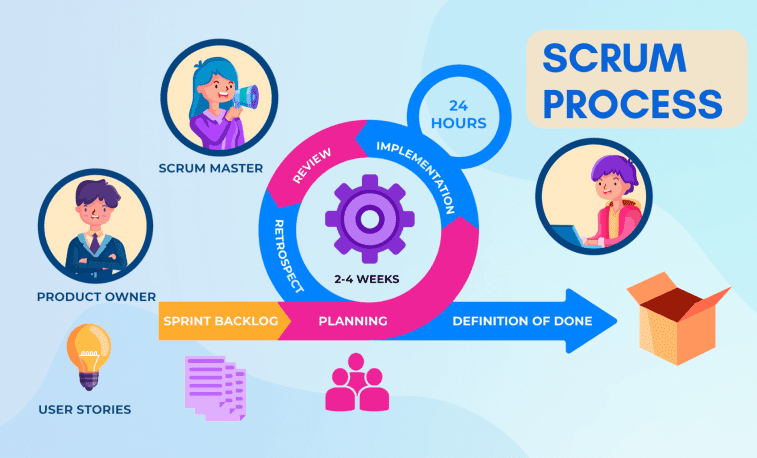
Scrum model
Phases of the Scrum Model
- Product Backlog: During the product backlog phase, priority tasks are identified, and comprehensive information about the project to be developed is collected in a concise manner.
- Sprint: The sprint represents the core operational period within the Scrum process, encompassing a one-month timeframe in which the development of a potentially deliverable product occurs.
- Burn Down: The burn down phase involves tracking the progress of a Scrum project. After each sprint is concluded, the Scrum master assumes responsibility for updating the visual representations of progress.
When to use
- This methodology is applied when there is an urgent need for prompt outcomes.
- It is suitable for scenarios characterized by significant uncertainty and poorly defined responsibilities.
- It is also employed when a client demands a highly tailored development approach for a specific product.
#8 Kanban
Kanban stands out as a recognized framework for agile and DevOps software development. It relies on immediate capacity communication and full transparency regarding ongoing tasks.
Kanban serves as an adaptable method of visually managing work that adjusts as the team’s requirements evolve.
Kanban facilitates the clear visualization of work, enhancing comprehension and allowing easy sharing with others. This enables interested parties to stay informed. Consequently, we can ensure that the service is equipped to meet the customer’s needs effectively.
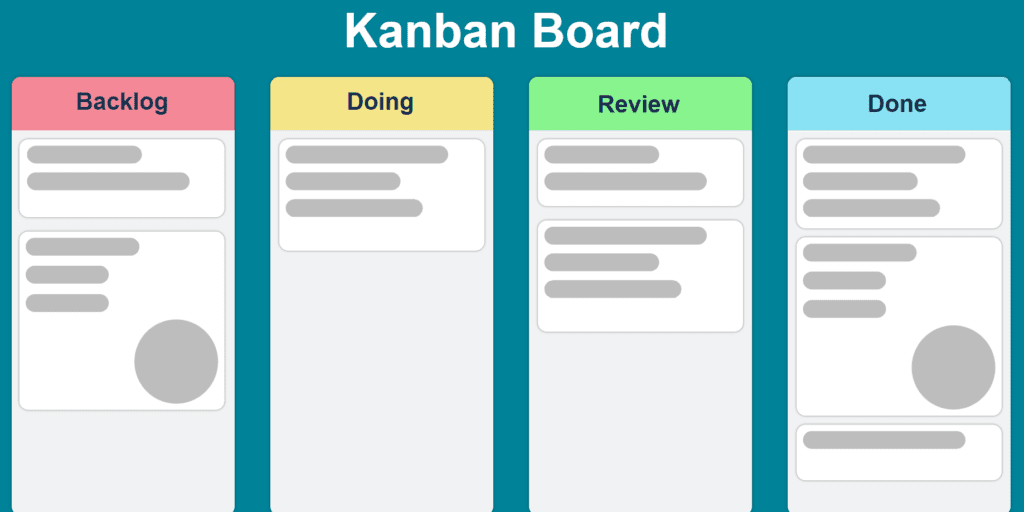
Phases of the Kanban Model
- Thoroughly identify and provide detailed explanations for each manufacturing process.
- Create a visual representation of these processes by assigning each one to a card and placing it on the Kanban board.
- Once the processes are visually represented, the primary focus shifts to identifying issues, such as bottlenecks, and making necessary revisions and optimizations.
- Strive to minimize work in progress, meaning that you should aim to limit the number of ongoing tasks, enabling employees to concentrate on the most critical ones.
- Collect measurements and take action based on them. Since Kanban is a dynamic approach, it’s crucial to assess the outcomes and implement measures to enhance the situation.
When to use
- When the goal is to eliminate superfluous procedures and methods.
- When you require a framework that facilitates a seamless progression in the development process.
- When the objective is to consistently enhance the system’s performance and efficiency.
#9 Extreme Programming (XP)
The Extreme Programming (XP) method allows experts to introduce alterations even once the iteration has commenced, typically concluding within a span of 1 to 2 weeks.
XP, short for Extreme Programming, represents an agile development methodology that aims to efficiently, flexibly, and systematically develop and manage projects. Its foundation lies in effective communication, the reuse of generated code, and a constant feedback loop.

Extreme programming model
Phases of Extreme Programming
- Planning: User stories are ranked by priority and segmented into smaller iterations based on their significance. This stage involves periodic planning reviews for reassessment.
- Implementation: During this phase, coding is carried out using a simplified approach, focusing solely on achieving basic functionality. This enables the creation of a prototype.
- Quality Assurance: Coding is performed collaboratively, with two programmers sharing the same computer—a “two-handed” approach. It is common for partners to switch roles. This practice ensures the development of code that is comprehensible and usable by any other programmer.
- Deployment: If we have reached this stage, it signifies that all user stories or mini-iterations have been successfully tested while keeping the client’s requirements in mind.
When to use
- There is continual and transparent communication between the client and the development team.
- Rapid adaptability is essential due to frequent changes.
- Planning is flexible, characterized by an open schedule of activities.
- Prioritizing working software over extensive documentation.
- The primary success indicators for the project are the client’s requirements and the team’s efforts.
- Collaborative project work can be conducted remotely.
Building software products that stand out
Building software products is an intricate and time-intensive process. Nevertheless, with the right strategies and a dedicated team, achieving this goal is entirely feasible.
Here at CMC Global, we recognize the significance of staying up-to-date with the latest industry trends, implementing best practices, and fostering a culture of continual learning. This dedication has enabled us to deliver robust, inventive, and efficient software solutions to our clients.
Whether you’re interested in developing a new software product, enhancing an existing one, or exploring offshore development opportunities, we’re at your service.
Our team of professionals is eager to discuss your project objectives and explore how we can assist you in constructing outstanding software solutions that distinguish themselves in the market.
Don’t hesitate to get in touch – let’s start the journey of creating exceptional software together.
